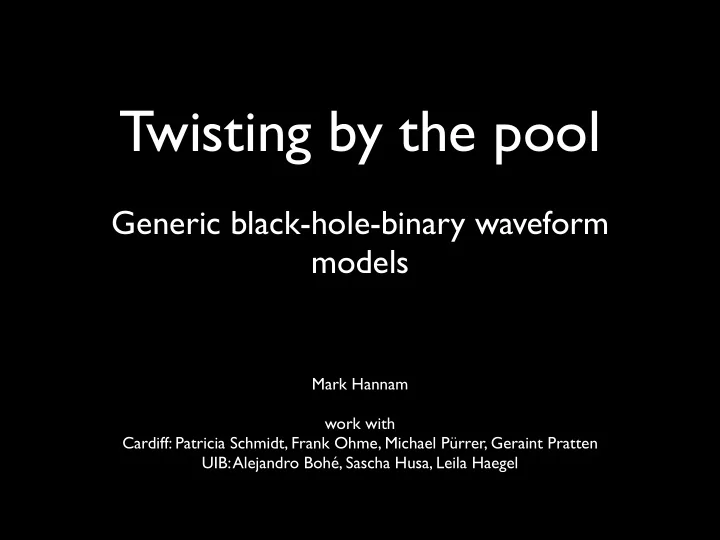

Twisting by the pool Generic black-hole-binary waveform models Mark Hannam work with Cardiff: Patricia Schmidt, Frank Ohme, Michael Pürrer, Geraint Pratten UIB: Alejandro Bohé, Sascha Husa, Leila Haegel
Motivation The future of gravitational wave astronomy depends on us!
Black-hole-binary parameter space Phenom (2007) Nonspinning EOBNR (2007--) PhenomB (2009) Spinning, PhenomC (2010) non-precessing SEOBNR (2010) PhenSpin (2010) SP-EOBNR (2013) Generic PhenomP (2013)
Untangling precession [Schmidt et al, 2012]: We can model generic-binary waveforms by “twisting up” a non-precessing model
PhenomC h ( f ) = A ( f ) e i Ψ ( f ) • Inspiral: TaylorF2. • Merger-ringdown: - power series in f, fit to NR data - final spin from formulas in literature
Do the twist ˆ J ˆ L ι Twist: ( ι ( t ), α ( t ), ε ( t )) α y x (˙ ✏ = ˙ ↵ cos ◆ )
Precession parameter • Non-precessing binaries: inspiral rate modfied by “inspiral spin”, χ e fg • Precessing binaries: precession rate determined by “precession spin”, χ p • χ p : average of the dominant term in PN precession equation 0.85 0.80 0.75 Χ p 0.70 0.65 0.60 0 50000 100000 150000 200000 250000 300000 t � M ⇥
Single-spin binaries • If our approximations hold, we can apply ( χ e fg , χ p ) to just one black hole • “Physical Template Family” (PTF) studies: single-spin models effective across most of parameter space • New insight: identification of “equivalent” generic systems
Orbital plane tilt, ι ( t ) J · ˆ ˆ ˆ J cos ι = L ˆ L L + S || ι = q ( L + S || ) 2 + S 2 ⊥ α y x L(t) (or L(f)) can be calculated from PN theory ι ( t ) mostly affects mode amplitudes, not phases...
Precession angle, α ( t ) • Strongly affects waveform phase • For a single-spin model, to leading order: ◆ J ✓ 2 + 3 m 1 Ω p = r 3 2 m 2 • We use next-to-next-to leading order in spin-orbit terms
Stationary phase approximation e im 0 ✏ d 2 2 m ( t ) = e − im ↵ X h P m 0 ,m ( − ι ) h 2 ,m 0 ( t ) | m 0 | =2 • Assume waveform amplitude varies slowly: Ψ ( v ) = 2 π ft ( v ) − φ ( v ) • Precession angles also vary slowly • See also [Lundgren and O’Shaughnessy 2013]
Merger and ringdown • J is approximately fixed • Use final spin estimates [Barausse, et. al. 2009] Crude approximations: • Use PN angles through merger/ringdown • Use SPA through merger/ringdown.
Testing the model: PN-NR hybrids Hybridize waveforms in co- precessing frame ι L [Schmidt, et al 2012] 1.0 ( q = 1, 2, 3; 0.5 single & double-spin g @ rad D 0.0 α cases) - 0.5 - 1.0 - 300 - 200 - 100 0 100 200 300 t @ M D Also use NR initial parameters and evolve PN backwards in time
Comparisons Most extreme comparison: q =3, χ p = 0.75, 50 M ⊙ Against PhenomC Against PhenomP
To do list • Implement for general use & testing • Perform simulations across ( q , χ e fg , χ p ) • Calibrate model to simulations • Verify / improve assumptions • Improve merger/ringdown model
Recommend
More recommend